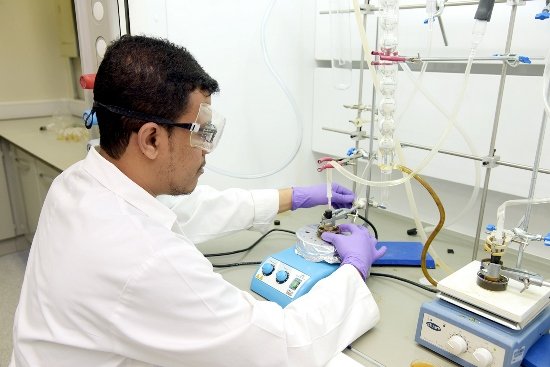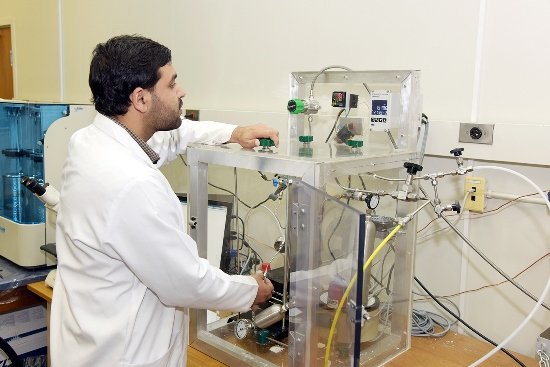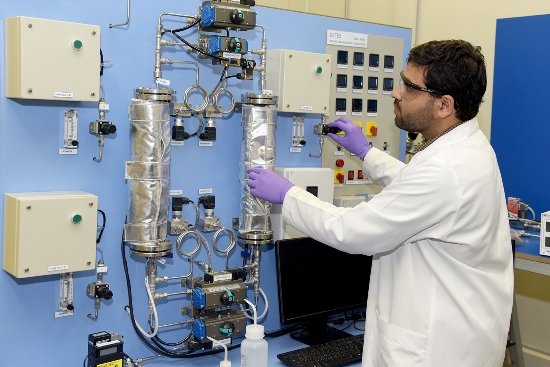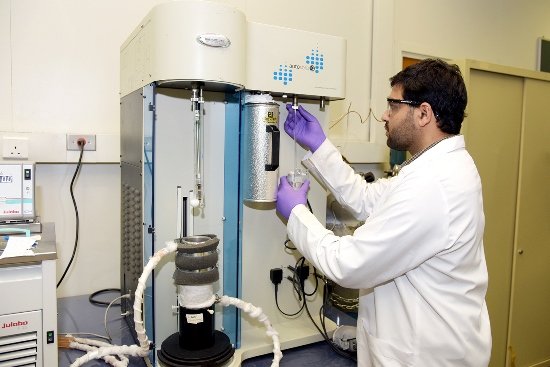Environmentally friendly technologies and projects to reduce carbon emissions
Feb. 7, 2017 | Research
KFUPM raised a number of scientific projects that aim to reduce carbon emissions, implemented by the technical innovation Centre for carbon capture and storage.
The first project deals with the development of an absorption system to separate CO2, and aims to develop technologies to manage CO2 emissions from stationary and mobile sources. The main objective of this project is to develop, test and evaluate the absorption system to reduce CO2 emissions from stationary and mobile sources. The project includes a synthesis of highly efficient absorption material based on metal organic frameworks (MOFs) and zeolites. Moreover, the project helps to discover extensive production methods of MOFs and synthesizing on the laboratory scale, designing easy-to-integrate systems to separate CO2 from stationary and mobile sources using simulations and experimental.
The second project is entitled "development of membrane technology for oxygen separation". The project aims to develop carbon-free burners using ceramic membranes. This can be achieved by integrating the ceramic membranes with combustion systems such as gas turbine combustion chambers that can provide an environment with high temperature and high Oxygen flow rates. Fuel reacts on the membrane side with Oxygen moved through the membrane to produce a very low concentration of Oxygen on the side of the fuel and thus different concentration across the membrane to achieve high flows of Oxygen.
The third project focuses on the use of chemical combustion cycles to get rid of CO2 resulting from energy production. The project aims to develop new technology to get rid of CO2 emission using chemical loop combustion (CLC). It also aims to develop a Nickel supporter to the Oxygen holder to use it in CLC.
The fourth project is concerned with the influence of CO2 injection on the physical properties of reservoir rocks and rock cover. This project aims to inject these reservoirs with CO2 to return their balanced pressure to its natural proportions.

The fifth project deals with CO2 leak monitoring by surface geophysical methods under the desert surface conditions. The primary objective of this research is to study the feasibility of monitoring the CO2 leaks from geological reservoirs under these circumstances by studying changes in the physical properties of the surface layers, in addition to the processing and analysis of scattered waves using computer models based on finite difference solutions to wave equation.
The innovation and Technology Center for carbon capture and storage (KACST-TIC-CCS) at KFUPM was created by King Abdulaziz City for science and technology (KACST) to contribute to the reduction of CO2 emission rates, and therefore participate in maintaining a healthy and clean environment.
As KACST-TIC-CCS aims to be a reputed regional Centre in the CCS field, and to contribute actively in converting existing technology that is based on traditional sources of energy which contaminates environment to other perfectly clean technologies that will help creating a clean environment in Saudi Arabia. Moreover, since its inception, the Centre has been conducting a variety of research and developing innovative techniques, in addition to developing training and education programs that will help building the young generation (from KFUPM’s graduate engineers) that is aware of this technology and is capable of utilizing it properly.
The Centre is concerned with strategic research areas relevant to carbon capture and sequestration later to achieve excellence at international level (in cooperation with national and international universities/research organizations), leveling up quality, and contributing effectively to the implementation of projects.
How CCS works?
The energy generated from fossil fuels (e.g., natural gas and coal) results in releasing CO2 into the atmosphere, and thus carbon capture technique is used. This technique is exploited extensively in major industrial countries, especially in the cement, iron, ad steel, and paper mills. Canada, United States, industrial European Nations, China and Australia are at the forefront of the countries exploiting this technology to separate CO2 from gases emitted from chimneys at different concentrations.

CCS Technique and the solution of the global warming problem:
This technique effectively provides a radical solution to the problem of CO2 emissions, and thus contributes to the solution of the global warming problem. The global warming problem appears from time to time, and scientists confirm it is the product of increasing rates of greenhouse gas emissions, particularly CO2. The big problem behind global warming comes from complete ignorance of these increasing emission rates worldwide, and proceeding to further pollute the atmosphere more and more, by constantly relying on the usual sources of energy such as natural gas, coal and oil in the coming decades. Some sources indicate that the rely on traditional energy resource will continue by 60%, despite efforts at the international level such as the Kyoto Protocol and the 2009 United Nations Conference on climate change held in Copenhagen. However, the CCS technique can be a fundamental solution to this problem.
It is also possible to alleviate this growing problem by using alternative energy resources such as nuclear power, renewable energy resources such as wind and solar power, and energy generated by the dams. Nevertheless, it is difficult to fully rely on these sources to provide power, since they do not provide energy fast enough, have high operating costs, not to mention research, development, and upgrade costs. Therefore, these resources cannot cover the whole energy needs but very small proportions. Hence, the CCS technology is very important, because it is less expensive than alternative energy resources, and the traditional methods can be adapted by the addition of air purification from CO2, which is provided by the CCS technique.

The CCS technology can be divided into three categories:
- Separation of carbon dioxide from gas residues.
- Burning in oxygen instead of air.
- Production of a carbon free fuel.
These categories are marked with a number of features and set of flaws. A major flaw is the relatively high cost at the beginning of operation.
Carbon capture and storage Centre… A summary of the record of achievements
3 patents in the area of CCS.
Over 23 research papers in scientific journals.
About 11 scientific research papers in global conferences.
Conducting 2 workshops in 2013 and 2015.
Organization of 10 lectures by international lecturers in the field of CCS.
Preparation of an integrated course in the area of CCS (expected to be taught next semester).
Organization of a training course in the field of CCS.



